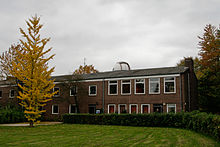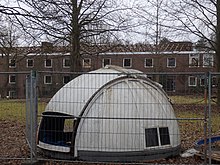Lübeck observatory
The Lübeck observatory was a school and public observatory operated by the working group Sternfreunde Lübeck eV . Until it was demolished in early 2017, it was on the roof of the Johannes Kepler School on Ährenfeld. She cooperated with the Lübeck University of Applied Sciences .
history
The history of the Lübeck observatory began after the Second World War , when the Baltic astronomer Dr. Peter von der Osten-Sacken settled in Lübeck. At this point in time the observatory of the Lübeck Seafaring School was in a sad state, all optical instruments had been lost. In addition, the monastery courtyard school had a simple planetarium , a “star chamber”.
Von der Osten-Sacken gave lectures on astronomy at the community college, which was soon to be rebuilt . However, a telescope for practical observation was initially missing . The vice-principal of the Klosterhofschule procured a portable telescope that was placed on the roof of the school and used for public observations.
Since the instrument was too small, von der Osten-Sacken tried to buy a larger telescope and set up an observatory. In 1951 a reflector telescope with an aperture of 25 cm and a focal length of 2 m was ordered from the Hamburg company Butenschön. The telescope was to be set up on the roof of a new school building, which was still being planned. In the meantime the telescope has been set up on the roof platform of the monastery courtyard school. A sheet metal housing on rollers served as weather protection. The observatory was attached to the adult education center, and von der Osten-Sacken was appointed official director in 1952. During this time, we worked closely with the professional observatory in Hamburg-Bergedorf .
After the completion of the Johannes Kepler School in 1957, the dome was mounted on its roof. At that time, the manager only had a small office and a small work room. The official inauguration took place on February 24, 1959.
In the following years, more and more visitors took part in the public tours, astronomical working groups were formed to observe sunspots and variable stars and to work in the field of astrophotography . The working group Sternfreunde Lübeck eV (ASL) was finally founded by the working groups.
Soon there was a desire for a new, more powerful telescope. In 1974 a Newton-Cassegrain telescope with a 48 cm primary mirror and a focal length of 2 m or 6 m (depending on the equipment) was put into operation. For a long time, the telescope was the largest device used by amateur astronomers in Schleswig-Holstein .
In 1990 Dieter Kasan, professor for mathematics and physics at the Lauenburg School of Academics in Ratzeburg, took over the management of the observatory. In 1993 the observatory received two more rooms in the school, which are used as seminar and work rooms. In 1994 the Possehl Foundation Lübeck donated a CCD camera with a computer system for astrophotography . Since 1997 the observatory has had a grid spectrograph for examining star spectra and the speed of objects. At the suggestion of the head of the observatory, it was designed as a diploma thesis at the Lübeck University of Applied Sciences by Bernd van der Smissen under the guidance of Edmund Koch and built by the workshop of the University of Applied Sciences with a grid donated by Dieter Kasan. Another donation from the Possehl Foundation made it possible to renovate the dome and purchase new equipment in 2004. In February 2007, the responsibility for the observatory was transferred to the ASL.
Dieter Kasan died on July 29th, 2009. After a decision by the board of directors of the ASL, it was announced on September 4th, 2009 that the observatory management would in future consist of a technical and a scientific director. Technical management was transferred to the previous deputy head, Andreas Goerigk. Dr. David Walker.
The Lübeck observatory regularly offers public tours and astronomical lectures.
Instruments
The main instrument is a 20 "- Ritchey-Chretien telescope for observing. Sun , planets and function as a conduit pipe one will telescope with 140 mm opening width and 1000 mm focal length used Both will be supported by an equatorial mount from the American manufacturer Astro. -Physics: The modernization of the instruments was completed with the assembly of the refractor on February 13, 2010. The instruments were presented to the public in a festive setting on March 20, 2010. The acquisition of both telescopes and the new mount was made possible by Possehl Foundation and the Dräger Foundation The old dome telescope went to the VHS observatory in Neumünster , with which the observatory in Lübeck maintains a close cooperation.
There are also several transportable telescopes, u. a. a 12 " Dobsonian and a PST (Personal Solar Telescope) are available for observing the sun.
Lecture program
The regular, constantly changing Friday evening lecture program on the history of astronomy, astrobiology, astrophysics, space travel, observatories and many other topics can be found on the website of the Lübeck observatory, as well as in the showcase directly at the Lübeck observatory, at the address: Am Ährenfeld 2, 23564 Lübeck, in the Citizens Academy Program of the Hanseatic City of Lübeck and in the program leaflets, which are available free of charge in the city library, adult education center, in the tourism center and in numerous museums during the lecture season. The lecture program can also be conveniently downloaded as a PDF file directly from the website of the Lübeck observatory.
future
The future of the Lübeck observatory is uncertain. School operations continued until Easter 2016. The observatory cleared the school building on December 31, 2016. From January 2017 the school building was demolished so that a new residential area, the Johannes-Kepler-Quartier, can be created. The observatory ended in November. A new location has not yet been found.
Web links
Individual evidence
- ↑ a b Demolition of the Kepler School has started , hl-live from January 2, 2017, accessed on January 2, 2017
Coordinates: 53 ° 51 ′ 32 " N , 10 ° 43 ′ 41" E


